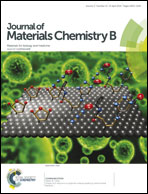Two-photon fluorescent Bombyx mori silk by molecular recognition functionalization†
Abstract
Two-photon fluorescent (TPF) Bombyx mori silk fibers were acquired for bioimaging by molecular recognition functionalization. In this context, 2,7-bis((E)-4-((E)-4-nitrostyryl)styryl)-9,9-dioctyl-9H-fluorene (NF) was adopted to functionalize silkworm silk fibers. NF exhibits a large two-photon absorption cross section, but has a low TPF quantum yield in the solid form due to the side-by-side (π–π) molecular stacking. In terms of the molecular recognition between the nitro groups of NF and the amide groups of silk fibroin, the silk fibers acquire the two-photon fluorescent emission with a significant enhancement of 350% in TPF quantum yield of NF molecules, compared with the solid state. For comparison, two other molecules, 2,7-bis((E)-4-methylstyryl)-9,9-dioctyl-9H-fluorene (MF1) and 2,7-bis((E)-4-((E)-4-methylstyryl)styryl)-9,9-dioctyl-9H-fluorene (MF2), were selected for similar experiments. These molecules show little effect due to the lack of molecular recognition. The TPF silk scaffolds were obtained, and high quality imaging of NF in cell culture was finally achieved, which has extremely relevant implications for biomedical applications.


 Please wait while we load your content...
Please wait while we load your content...